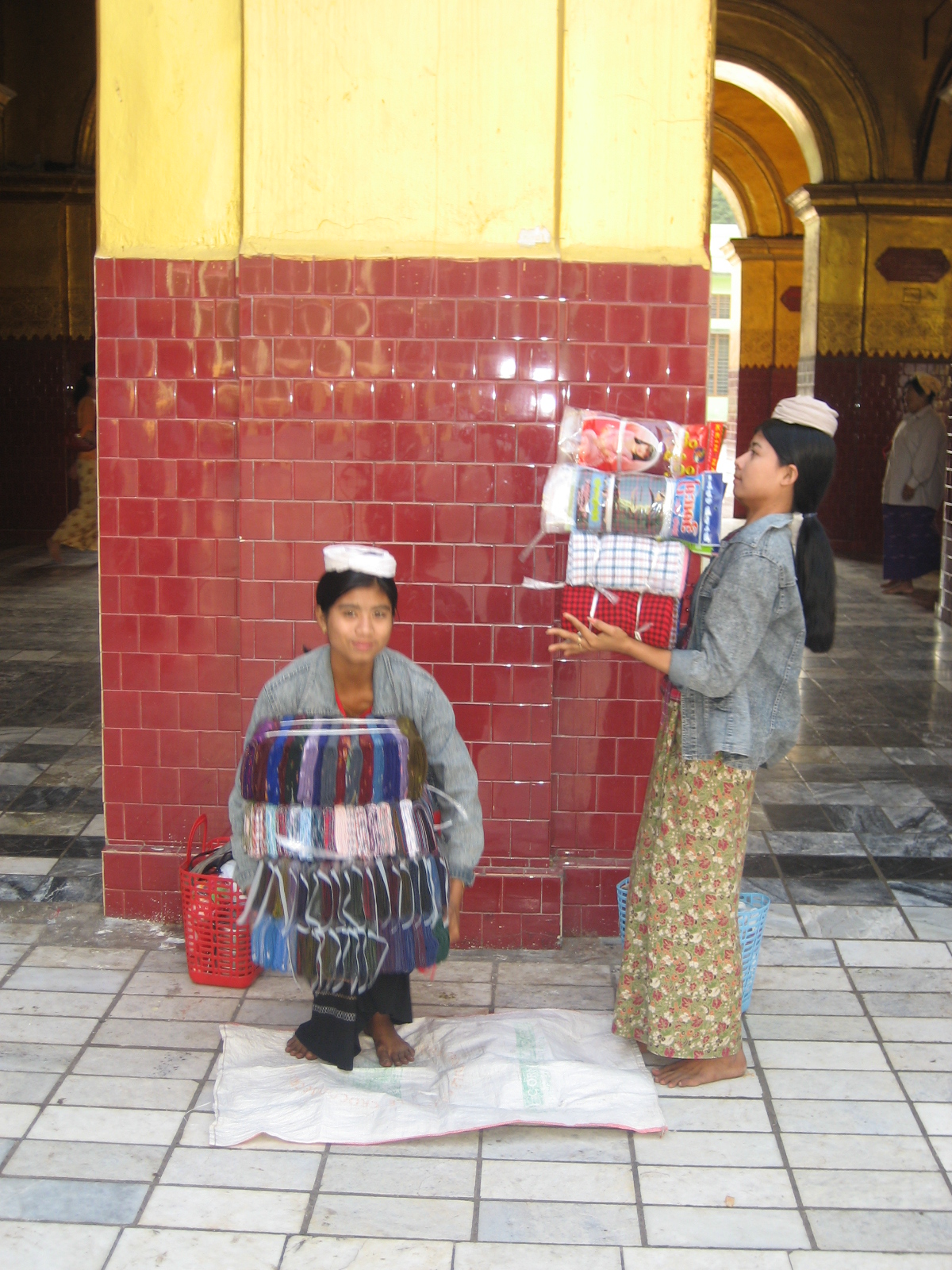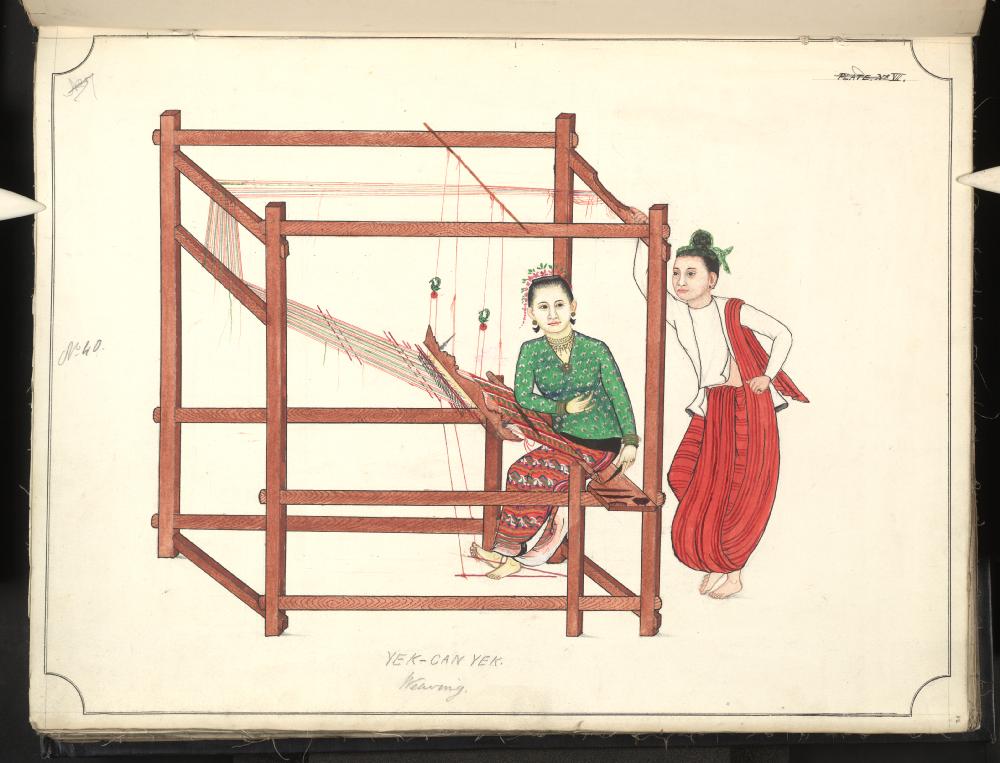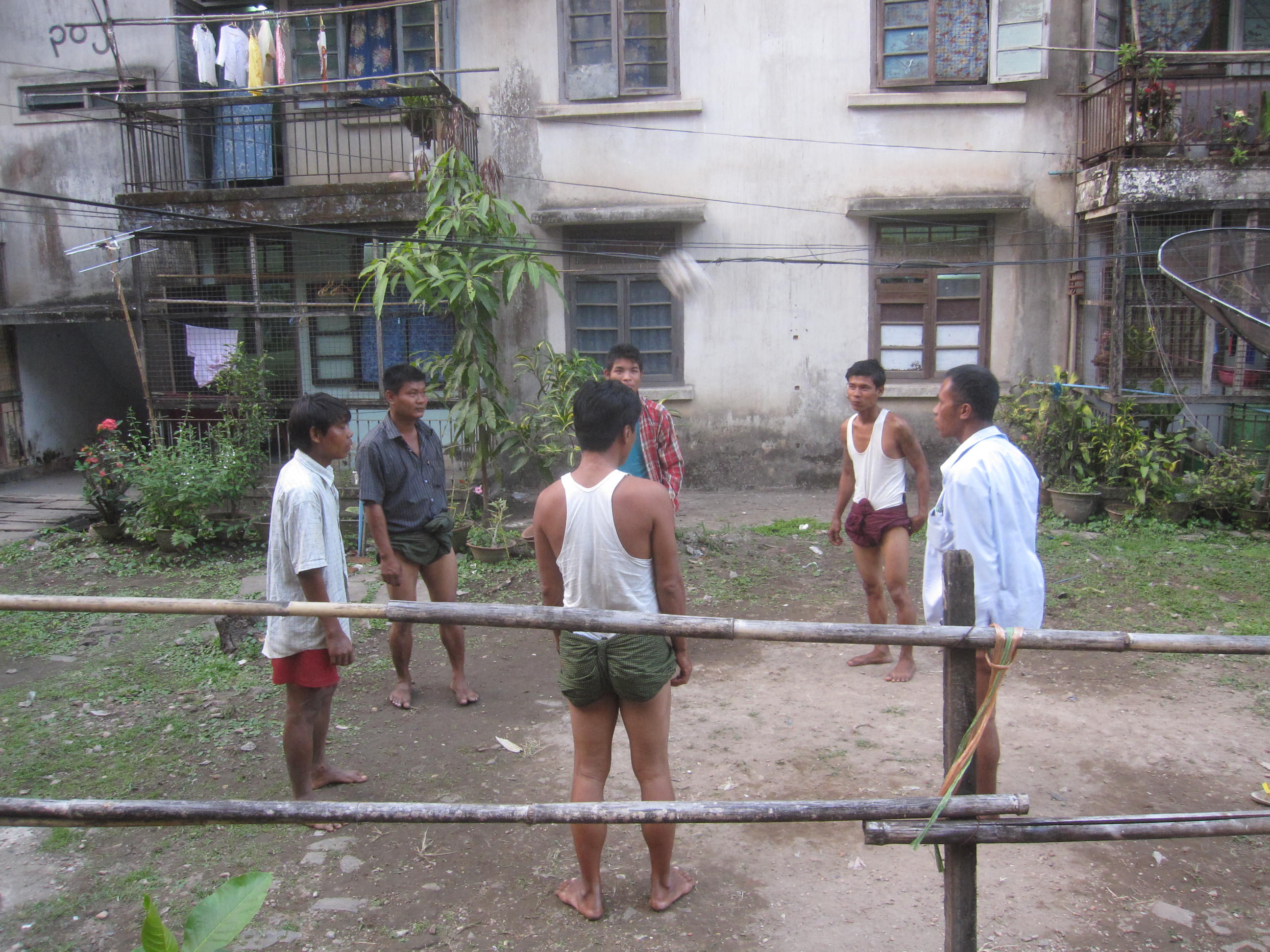Longyi on:
[Wikipedia]
[Google]
[Amazon]
A longyi (; ) is a sheet of
 The modern ''longyi'', a single piece of cylindrical cloth, is a relatively recent introduction to Burma. It gained popularity during British
The modern ''longyi'', a single piece of cylindrical cloth, is a relatively recent introduction to Burma. It gained popularity during British  A western visitor to
A western visitor to  Visiting
Visiting

 Men's pasos are generally stripes or checks apart from plain colours and may be worn upside down or inside out with no difference. Women's htameins have a black calico band called ''a htet sint'' (, ) for the waist; they wear more multi-coloured and floral patterns, too.
Cotton is the basic material but all sorts of fabrics, both imported and home-grown, may be made into longyis. Tootal, georgette, satin and crepe have been made into htameins.
Men's pasos are generally stripes or checks apart from plain colours and may be worn upside down or inside out with no difference. Women's htameins have a black calico band called ''a htet sint'' (, ) for the waist; they wear more multi-coloured and floral patterns, too.
Cotton is the basic material but all sorts of fabrics, both imported and home-grown, may be made into longyis. Tootal, georgette, satin and crepe have been made into htameins.
Image:Acheik htamains.jpg, Acheik htameins, a private collection
Image:Kachin longyi.JPG, Kachin longyi with tartan design
 The longyi suits the climate as it allows some air to circulate and keeps cool in the hot sun. Silk is unique in keeping warm in the winter as well as cool in the summer.
The longyi is versatile. Men often tuck the lower portions of their pasos at the top by bunching it in the front then passing it up between the legs round the back to the waist, known as ''paso hkadaung kyaik'' and, rather like the
The longyi suits the climate as it allows some air to circulate and keeps cool in the hot sun. Silk is unique in keeping warm in the winter as well as cool in the summer.
The longyi is versatile. Men often tuck the lower portions of their pasos at the top by bunching it in the front then passing it up between the legs round the back to the waist, known as ''paso hkadaung kyaik'' and, rather like the
Image:Paso hkadaung kyaik, Ngahtatgyi Buddha, Yangon.JPG, A statue wearing a ''paso hkadaung kyaik''
File:Bodleian Ms. Burm. a. 5 fol 162.jpg, Watercolour painting from 1897 depicting a 19th-century boxing match. All fighters wear longyi and Htoe Kwin tattoos.
Myanmar Fashion from Myanmar Image Gallery
{{Lethwei Skirts Burmese clothing
cloth
Textile is an umbrella term that includes various fiber-based materials, including fibers, yarns, filaments, threads, and different types of fabric. At first, the word "textiles" only referred to woven fabrics. However, weaving is n ...
widely worn in Myanmar
Myanmar, officially the Republic of the Union of Myanmar; and also referred to as Burma (the official English name until 1989), is a country in northwest Southeast Asia. It is the largest country by area in Mainland Southeast Asia and has ...
(Burma). It is approximately long and wide. The cloth is often sewn into a cylindrical shape. It is worn around the waist, running to the feet, and held in place by folding fabric over without a knot. In ancient times, lethwei
Lethwei (; International Phonetic Alphabet, IPA: ) or Burmese boxing is a Full contact fighting, full contact combat sport originating from Myanmar and is considered as one of the most brutal martial arts in the world.}
*
*
*
*
*
* Lethwe ...
fighters would hitch it up (paso hkadaung kyaik) to compete. This folding technique is still being used in modern days when people play chinlone
Chinlone (, ), also known as caneball, is the traditional, national sport of Myanmar (Burma). It is non-competitive, with typically six people playing together as one team. The ball used is normally made from hand-woven rattan, which sounds like a ...
.
History
 The modern ''longyi'', a single piece of cylindrical cloth, is a relatively recent introduction to Burma. It gained popularity during British
The modern ''longyi'', a single piece of cylindrical cloth, is a relatively recent introduction to Burma. It gained popularity during British colonial rule
Colonialism is the control of another territory, natural resources and people by a foreign group. Colonizers control the political and tribal power of the colonised territory. While frequently an imperialist project, colonialism can also take ...
, effectively replacing the ''paso'' and ''htamein'' of precolonial times. The word ''longyi'' formerly referred to the sarong
A sarong or a sarung (, ) is a large tube or length of textile, fabric, often wrapped around the waist, worn in Southeast Asia, South Asia, Western Asia, Northern Africa, East Africa, West Africa, and on many Pacific islands. The fabric often ...
worn by Malay men.
In the precolonial era, men's pasos used to be a long piece of called ''taungshay paso'' () and unsewn. Alternately the ''htamein'' was a long piece of cloth open at the front to reveal the calves, with a dark strip of cotton or velvet sewn on the upper edge, a patterned sheet of cloth in the middle and a strip of red or white cloth sewn below, trailing on the bottom like shorts train
A train (from Old French , from Latin">-4; we might wonder whether there's a point at which it's appropriate to talk of the beginnings of French, that is, when it wa ... , from Latin , "to pull, to draw") is a series of connected vehicles th ...
. Paso was commonly worn by men in 19th century Burma and Thailand. The amount of cloth in the paso was a sign of social status.
 A western visitor to
A western visitor to Rangoon
Yangon, formerly romanized as Rangoon, is the capital of the Yangon Region and the largest city of Myanmar. Yangon was the List of capitals of Myanmar, capital of Myanmar until 2005 and served as such until 2006, when the State Peace and Dev ...
in the 19th century wrote:
 Visiting
Visiting Amarapura
Amarapura (, , ; also spelt as Ummerapoora) is a former capital of Myanmar, and now a township of Mandalay city. Amarapura is bounded by the Irrawaddy river in the west, Chanmyathazi Township in the north, and the ancient capital site of Ava ...
, Henry Yule
Colonel (United Kingdom), Colonel Sir Henry Yule (1 May 1820 – 30 December 1889) was a Scottish Oriental studies, Orientalist and geographer. He published many travel books, including translations of the work of Marco Polo and ''Mirabil ...
described the pasos and their equivalent for women, the htameins, as "the most important article of local production", employing a large proportion of the local population. The silk was imported from China. He wrote:
However, with the onset of colonial rule, Lower Burma
Lower Myanmar (, also called Lower Burma) is a geographic region of Myanmar and includes the low-lying Irrawaddy Delta ( Ayeyarwady, Bago and Yangon Regions), as well as coastal regions of the country ( Rakhine and Mon States and Tanintharyi ...
and urban areas more readily adopted the ''longyi'' worn in the Malay and Indian style, which was considered more convenient to wear.
Design and style
In Burma, longyis worn by males are called ''pahso '' (), while those worn by females are called ''htamein'' (, or ''htamain''). Strictly speaking, they are not unisex attire, as the way they are worn as well as the patterns and makeup are different between the genders. Men wear the modern paso by making a fold on either side in front and tied by tucking them together at the waist just below the navel. Women, on the other hand, always have a three cubit one finger span length but again unsewn in the old days like men's. They are worn wrapped around with a single broad fold in front and the end tucked in on one side or folding back at the hip and tucking into the opposite side of the waist, usually topped with a fitted blouse worn just to the waistband. Hemlines rise and fall as the fashion of the day dictates although they are unlikely to go up above the knee. Longyis are generally sold unsewn but nowadays they are available ready to wear; htameins may even be sewn like Western skirts. Untying and re-tying a longyi is often seen in public with both genders, women much more discreetly than men.Patterns and fabrics
 Men's pasos are generally stripes or checks apart from plain colours and may be worn upside down or inside out with no difference. Women's htameins have a black calico band called ''a htet sint'' (, ) for the waist; they wear more multi-coloured and floral patterns, too.
Cotton is the basic material but all sorts of fabrics, both imported and home-grown, may be made into longyis. Tootal, georgette, satin and crepe have been made into htameins.
Men's pasos are generally stripes or checks apart from plain colours and may be worn upside down or inside out with no difference. Women's htameins have a black calico band called ''a htet sint'' (, ) for the waist; they wear more multi-coloured and floral patterns, too.
Cotton is the basic material but all sorts of fabrics, both imported and home-grown, may be made into longyis. Tootal, georgette, satin and crepe have been made into htameins. Indonesia
Indonesia, officially the Republic of Indonesia, is a country in Southeast Asia and Oceania, between the Indian Ocean, Indian and Pacific Ocean, Pacific oceans. Comprising over List of islands of Indonesia, 17,000 islands, including Sumatra, ...
n batik
Batik is a dyeing technique using wax Resist dyeing, resist. The term is also used to describe patterned textiles created with that technique. Batik is made by drawing or stamping wax on a cloth to prevent colour absorption during the dyein ...
, although very expensive, have been very popular for decades; outfits of batik () of the same design top and bottom were very popular in the 1980s.
For ceremonial and special occasions wearers use their best silks; the most elaborate ones are known as ''acheik
''Acheik'' (; ) or ''luntaya acheik'' (လွန်းတစ်ရာအချိတ်; ), is the name of the indigenous Burmese textile pattern. It features intricate waves interwoven with bands of horizontal stripes, embellished with arabesque ...
'' (, ), a beautiful and intricate wave or houndstooth
Houndstooth is a pattern of alternating light and dark check (fabric), checks used on fabric. It is also known as hounds tooth check, hound's tooth (and similar spellings), dogstooth, dogtooth or dog's tooth. The duotone pattern is characterized ...
pattern in several colour combinations from the weavers of Amarapura
Amarapura (, , ; also spelt as Ummerapoora) is a former capital of Myanmar, and now a township of Mandalay city. Amarapura is bounded by the Irrawaddy river in the west, Chanmyathazi Township in the north, and the ancient capital site of Ava ...
. They are worn especially at weddings, almost invariably by the bride and groom in matching colours. The poor may keep aside some traditional silks for special occasions.
In ancient times silks generally were worn by royalty and courtiers, the royal pasos and htameins richly embroidered with gold, silver, pearls and precious stones. Modern reproductions of these may be seen on the stage at ''zat pwè''s (theatrical performances).
Ethnic and regional weaves and patterns are plenty and popular. There are Rakhine longyi, Mon
Mon, MON or Mon. may refer to:
Places
* Mon State, a subdivision of Myanmar
* Mon, India, a town in Nagaland
* Mon district, Nagaland
* Mon, Raebareli, a village in Uttar Pradesh, India
* Mon, Switzerland, a village in the Canton of Grisons
* A ...
longyi, Kachin longyi, Inle Inle may refer to:
* Inlé, an album
* Inle Lake, a lake in Burma
* Inle, Aunglan, a village in Aunglan Township, Burma
* Inle, Thayet, a village in Thayet Township, Burma
* Inle (Santería), a character in Santería mythology
{{dab ...
longyi, Zin Mè (Chiang Mai
Chiang Mai, sometimes written as Chiengmai or Chiangmai, is the largest city in northern Thailand, the capital of Chiang Mai province and the List of municipalities in Thailand#Largest cities by urban population, second largest city in Thailan ...
) longyi, Yaw longyi, Seikkhun longyi, Dawei
Dawei (, ; , ; , RTGS: ''Thawai'', ; formerly known as Tavoy) is a city in south-eastern Myanmar and is the capital of the Tanintharyi Region, formerly known as the Tenasserim Division, on the eastern bank of the Dawei River. The city is about ...
longyi and more.
Silk pasos, but not ''acheik'', that men wear for special occasions are called ''Bangauk'' (Bangkok
Bangkok, officially known in Thai language, Thai as Krung Thep Maha Nakhon and colloquially as Krung Thep, is the capital and most populous city of Thailand. The city occupies in the Chao Phraya River delta in central Thailand and has an estim ...
) paso. ''Kala'' (Indian) paso are often longer and are worn by taller people; ''Kaka zin'' refers to a broad check pattern of black, brown and white worn by Indian teashop owners. Mercerised longyis from India are popular as the fabric is more durable.
Versatility and convenience
dhoti
The dhoti is an ankle-length breechcloth, wrapped around the waist and the legs, in resemblance to the shape of trousers. The dhoti is a garment of ethnic wear for men in the Indian subcontinent. The dhoti is fashioned out of a rectangular p ...
, usually for climbing and sporting activities instead of changing into shorts or trousers. Soldiers in ancient times wore their pasos in this manner either on their own or on top of a pair of trousers.
In rural areas men are often seen with a folded paso on one shoulder either for use when bathing (''yei lè'' — — longyi) or for use as a cushion for a carrying pole on the shoulder or a heavy load on the back. Women, when they bathe, simply wear their htamein higher by tucking it just under the arms to cover their breasts before removing the blouse; they may be seen using the htamein as a buoy in the river by trapping some air in and secured underneath by the hands. They use a man's paso or another piece of long fabric, rolled and coiled as a cushion on top of their heads to carry water pots, firewood, baskets and trays; it is the street hawker's customary way of carrying wares.
Changing is done simply by stepping into the new longyi and pulling it up, at the same time loosening and dropping the old one, or the new one can be pulled over from the head down. However, even when in private, women change without removing all their clothes. Instead, they will wear one htamein while changing into a new one. A woman may be seen pulling her htamein up bit by bit as she wades deeper and deeper into a river without getting it wet. It is merely a matter of lifting it up in the bathroom or in bed for that matter. Washing and ironing cannot be simpler as they are cylindrical pieces of cloth, easily hung, pressed, folded and stacked with a bare minimum use of wardrobe space.
Lethwei
In ancient times, traditionallyLethwei
Lethwei (; International Phonetic Alphabet, IPA: ) or Burmese boxing is a Full contact fighting, full contact combat sport originating from Myanmar and is considered as one of the most brutal martial arts in the world.}
*
*
*
*
*
* Lethwe ...
fighters would hitch up their longyi to compete in matches. Fighters would put it up as "shorts" called ''paso hkadaung kyaik'' to be able to use their legs and kick. Nowadays, in Lethwei matches fighters wear shorts which arbor a ''flag'' reminiscing of the longyi ancient days.
See also
*Dhoti
The dhoti is an ankle-length breechcloth, wrapped around the waist and the legs, in resemblance to the shape of trousers. The dhoti is a garment of ethnic wear for men in the Indian subcontinent. The dhoti is fashioned out of a rectangular p ...
References
14.Amitav Ghosh (2002) ''The Glass Palace'' pp 25,External links
Myanmar Fashion from Myanmar Image Gallery
{{Lethwei Skirts Burmese clothing